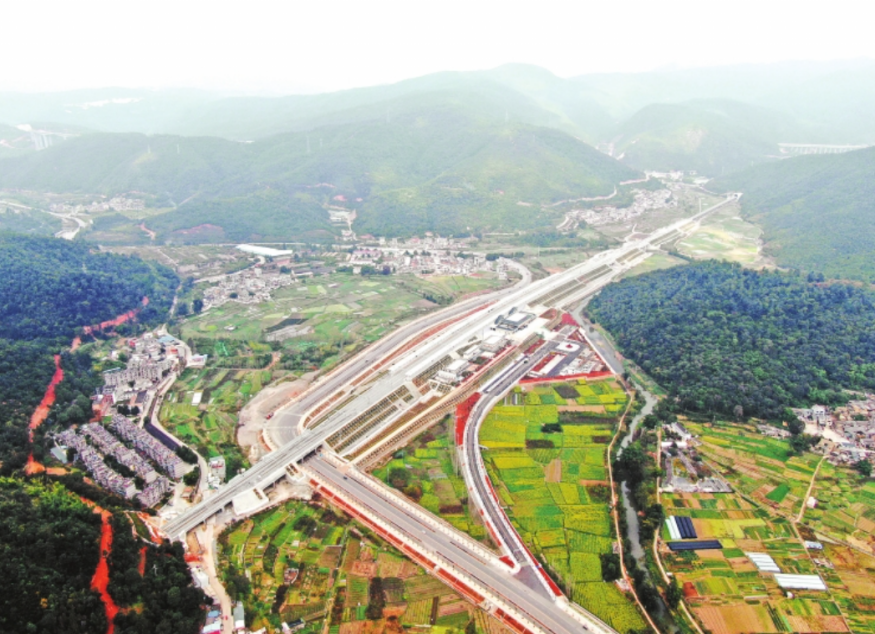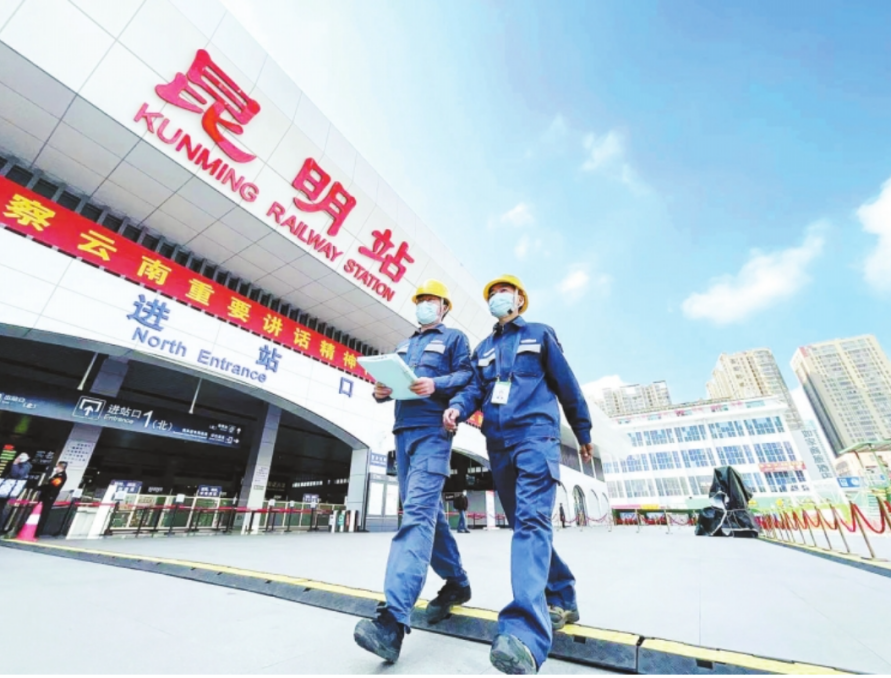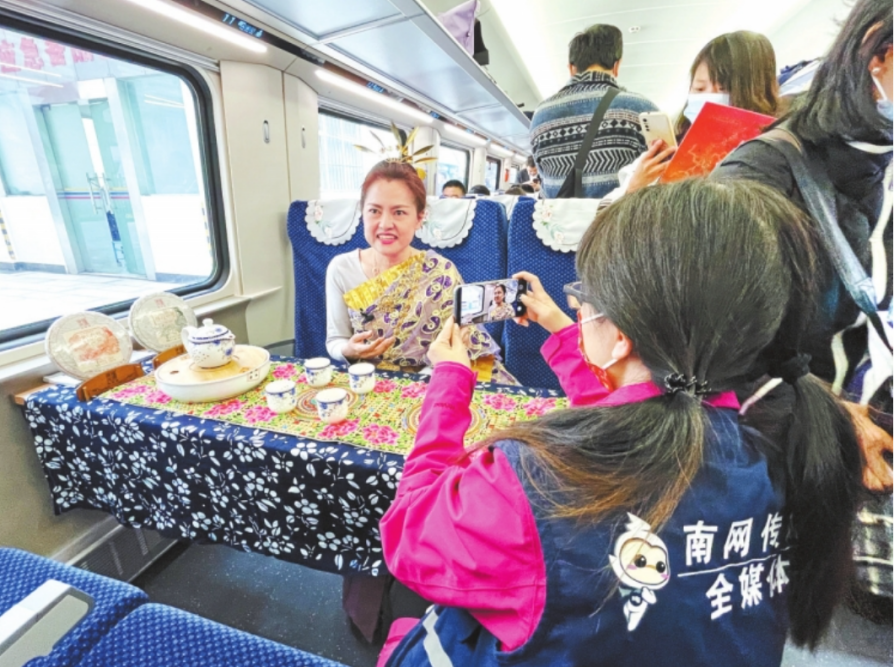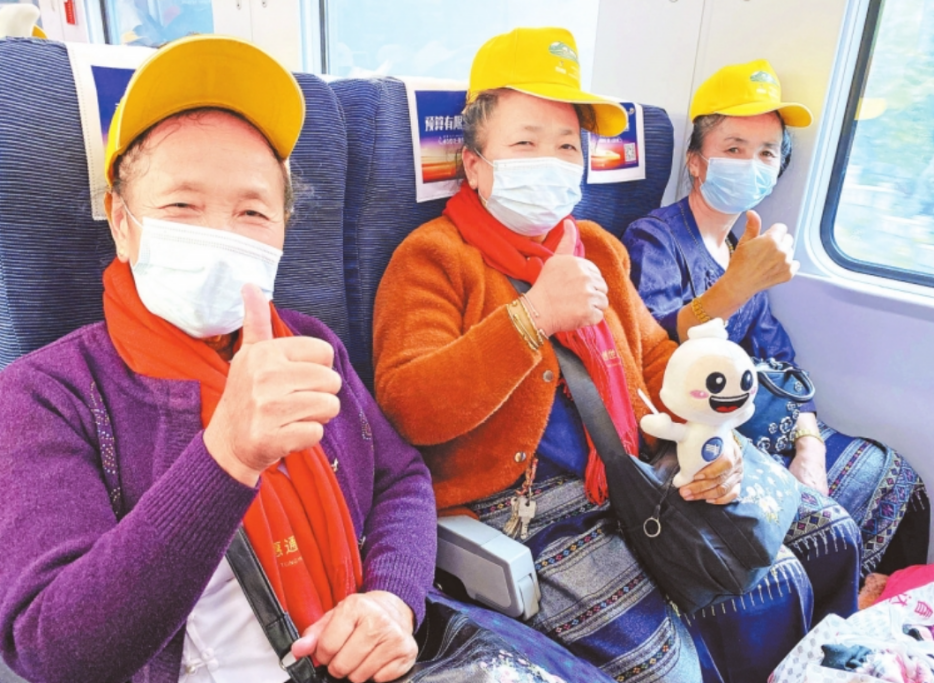from:China Southern Power Griddate:2021-12-06

Panorama of the varied external power supply lines of the Eshan Station of the China-Laos Railway.

Personnel from the Kunming Power Supply Bureau of Yunnan Power Grid Corporation examine the power equipment of the Kunming Railway Station, to ensure stable power supplies to the departure station of the China-Laos Railway.

Interviewing Dr. Jaruwan Udomsab from Thailand

Passengers welcoming the opening of the China-Laos Railway
On December 3, the China-Laos Railway was officially launched, marking the external power supply project entering into a new phase of operation and maintenance from engineering construction and debugging.
The entire length of the China-Laos Railway project was completed on August 31 this year, with the total length of 936 kilometers and 2,220 pylons. The whole line has been divided into varied sections in China and Laos, which are respectively invested, constructed, operated, and maintained by the Yunnan Power Grid Corporation and the Laos-China Power Investment Company, a joint venture between China Southern Power Grid Yunnan International and Électricité du Laos.
Électricité du Laos is the state corporation of Laos that owns and operates the country's electricity generation, electricity transmission and electricity distribution assets.
With the external power supply project, more power-technology management personnel will be trained and reserved for Laos
Since the Belt and Road Initiative was first put forward, the China-Laos Railway has been the first international railway significantly invested and built by China and also the first one directly connecting China's railway network. China's high technical standards and state-of-the art equipment have been adopted in constructing the entire length of the line. The China-Laos Railway is built to advance BRI standards and presents even more projects that benefit the local China and Laos society who can therefore can live a better life.
Zhao, a Laotian girl who used to study at Tongji University in China, participated in the Laos section of the external power supply project, and said that she was proud and happy to see the opening of the China-Laos Railway, "the transportation has been more convenient, so I can take my mom to my school in the future. The China-Laos Railway is a passenger and cargo railway. Therefore, the transportation of goods has also been more convenient. I can get the Chinese goods purchased online in a shorter time. Similarly, it won't take too much time for the Chinese people to get the local specialties from Laos."
While promoting economy and trade of the two countries, the China-Laos Railway will increase electricity load along the line, so it is the key to ensure the follow-up reliability of the power supply. The external power supply project, at its initial planning phase, has also been included in the construction of Yunnan power grid in the next decade.
Apart from a strong main grid, the pool of competent electrical technicians is also of vital importance. In constructing the Laos section of the project, a large number of local employees have been hired and received training; many Chinese mentors and Laotian apprentices have also forged many deep friendships.
“We hope to not only provide job opportunities and competitiveness for our employees, but also to reserve skillful personnel for the construction of Laos power grid in the future," Huang Wengang said.
After the external power supply project of China-Laos Railway enters the phase of operation and maintenance, the Laos-China Power Investment Company will continue to discuss how to further enhance the added value of the project in promoting local economic and social development.
"We will work with our Laotian partners to operate and maintain the external power supply project, and to carry out a series of technical exchanges and personnel training based on the project, so as to reserve more professionals in power technology management for Laos." Huang said, adding that China will not only bring advanced technology and experience to Laos, but also form an operation and maintenance management system with Lao characteristics based on local conditions, which is aimed to ensure long-term and stable power supply to the China-Laos Railway and truly make it a road of development and friendship.
Bearing in mind sustainable development, the CSG spared no efforts protect the local ecological environment during the construction
As the Railway is a green and low-carbon electrified one, it will further evolve into a road of development with many "pluses". It is the external power supply project invested by CSG that generates the "pluses".
Zhong Xiaotao, senior manager of CSG's International Cooperation Department, said, "the 'plus' refers to environmental protection: same standards and the latest technology have been adopted in both China and Laos to reduce environmental destruction. The 'plus’ also means shared benefits: we can cultivate a host of talents in the power industry for Laos, drive local employment and supply abundant power to the areas along the line."
The external power supply project includes a 936-kilometer-long power line and 2,220 pylons, and more than half of the line runs through mountainous regions. In constructing the project, various full-fledged technologies have been used to protect the local environment.
Mr. Zhong said that, “to build pylons, the top of a mountain might, in the past, be required to be flattened. However, by building pylons with legs of different heights, we can determine the length of the four legs according to the mountains and only four small parts need to be cleared up. In this way, the damage caused to vegetation can be minimized. After the project was completed, the constructors have also bought and sowed seeds of locally-grown grass to restore the original ecological environment. Pylons are higher than before, rising from 30 to 40 meters to 60 to 80 meters, which has diminished damage to surrounding vegetation and maintained migratory channels for animals.
He added that is China, “lucid waters and lush mountains seen as invaluable assets. It holds true for Laos."
"In Laos, a skilled worker earns about twice as much as an ordinary worker. If you want to increase your income, you need to improve your skills." said Aipian from Laos, the team leader of the second section of the Laos section, "In this project, I've learned many skills like pylon building, inspection and acceptance, and power lines erecting, which makes me more confident and competitive in applying for other projects."
The construction of the project has also improved the transportation infrastructure of the mountainous areas in northern Laos. In addition to builders' roads, the project has extended the roads to villages along the line, making it easier for villagers to transport agricultural and pasture products out of the mountains via small farm vehicles, instead of carrying the products by people or horses.
Musai comes from a village of Oudomxay, Laos. He said, "there was only one narrow road into the village, and it always turned to be muddy in rainy days. Now we have wide cobbled roads so that we can drive our tractors to take rice to Mueang Sai (the capital of Oudomxay) for sale. It's convenient." Wankan, from another village of Oudomxay, is looking forward to driving his beef cattle to the railway station near his hometown, transporting them up north, and selling them in China.
The opening of the China-Laos Railway will create many new business opportunities that greatly boost local economic and social development.
Tianrui, a winner of China Southern Power Grid scholarship, used to study in Kunming. He will now work as a driver on the Lancang bullet train on the Railway.
Five years ago, it was the first time for him to take the high-speed train from Kunming to Guiyang, and it has been an unforgettable experience.
"The train was going very fast and the carriages were full of passengers." Tianrui said adding, "Railway and power serve as important foundations of the economic and social development of Laos. We believe that the opening of China-Laos Railway will inject new momentum to Lao's development."
Tel:+86-25-84152563
Fax:+86-25-52146294
Email:export@hbtianrui.com
Address:Head Office: No.8 Chuangye Avenue, Economic Development Zone, Tianmen City, Hubei Province, China (Zip Code: 431700) Nanjing Office: Room 201-301, Building K10,15 Wanshou Road,Nanjing Area, China (Jiangsu) Pilot Free Trade Zone,Jiangsu Province,China (Zip Code:211899)
